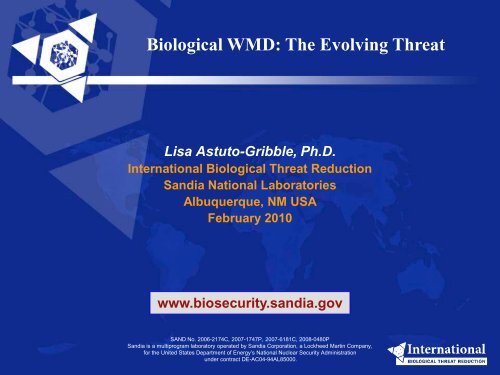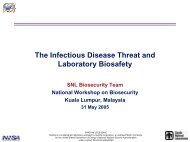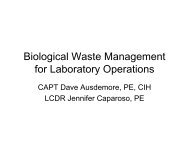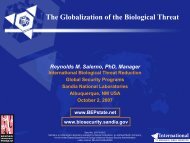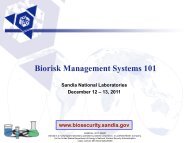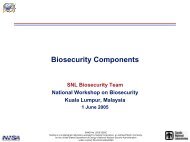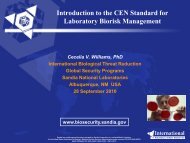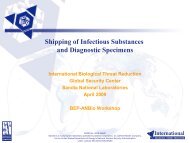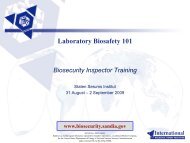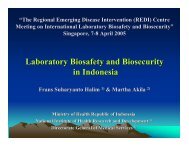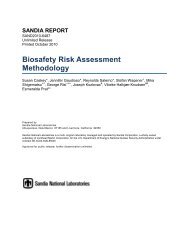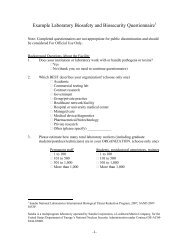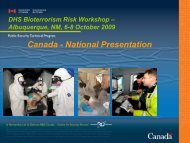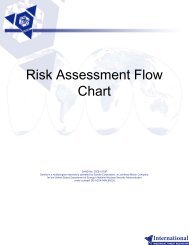Biological WMD - Sandia National Laboratories
Biological WMD - Sandia National Laboratories
Biological WMD - Sandia National Laboratories
Create successful ePaper yourself
Turn your PDF publications into a flip-book with our unique Google optimized e-Paper software.
<strong>Biological</strong> <strong>WMD</strong>: The Evolving Threat<br />
Lisa Astuto-Gribble, Ph.D.<br />
International <strong>Biological</strong> Threat Reduction<br />
<strong>Sandia</strong> <strong>National</strong> <strong>Laboratories</strong><br />
Albuquerque, NM USA<br />
February 2010<br />
www.biosecurity.sandia.gov<br />
SAND No. 2006-2174C, 2007-1747P, 2007-6181C, 2008-0480P<br />
<strong>Sandia</strong> is a multiprogram laboratory operated by <strong>Sandia</strong> Corporation, a Lockheed Martin Company,<br />
for the United States Department of Energy’s <strong>National</strong> Nuclear Security Administration<br />
under contract DE-AC04-94AL85000.
History of <strong>Biological</strong> Weapons<br />
• 1346: Tartar invaders catapulted plagueinfected<br />
bodies over city walls during siege<br />
of Kaffa<br />
• 1763: British soldiers distributed blankets<br />
used by smallpox victims to Native<br />
Americans during French and Indian Wars<br />
• World War I<br />
• Germany, France - anti-livestock sabotage<br />
• World War II – 1972<br />
• Japan, USSR, US, UK, Canada<br />
• Japanese use against Chinese targets<br />
• Alleged USSR use against German soldiers<br />
• Intent and effect of BW use was tactical,<br />
not strategic (influence battle, not war)
Source: Reynolds M. Salerno, Jennifer Gaudioso, Rebecca L. Frerichs, and Daniel Estes<br />
“A BW Risk Assessment Based on Historical and Technical Perspectives,” Nonproliferation Review,<br />
Fall-Winter 2004.
After the BWC Entered into Force<br />
• Biopreparat: The civilian arm of the<br />
Soviet biological weapons program<br />
• Established after Soviet accession into the<br />
BWC<br />
• 40 – 50 facilities with up to 60,000 employees<br />
• Other incidents<br />
• Iraq research program prior to 1991 Gulf War<br />
• Assassination of Bulgarian dissident<br />
• Alleged South Africa program to assassinate<br />
anti-apartheid activists<br />
Production Facility in Kazakhstan<br />
• Other suspected BW programs since<br />
1972<br />
• Iran, North Korea, Syria, Sudan, Cuba<br />
Munitions in Iraq
Scenarios for State<br />
<strong>Biological</strong> Weapons Proliferation<br />
Objectives Acquisition Development Dissemination<br />
•Defensive use<br />
in asymmetric<br />
scenario<br />
•Legitimate lab or<br />
culture collection<br />
(theft or fraud)<br />
•Advanced<br />
laboratory<br />
capabilities<br />
Sophisticated<br />
dissemination<br />
methods:<br />
•Offensive use<br />
in regional<br />
conflicts<br />
between<br />
symmetric<br />
states<br />
•Battlefield or<br />
other territory<br />
denial<br />
•Provided by another<br />
State<br />
•Derived from natural<br />
sources<br />
•Genetic engineering<br />
or chemical<br />
synthesis<br />
•Theft from transport<br />
- Weaponize<br />
- Grow<br />
- Test<br />
- QA<br />
- Store<br />
- Transport<br />
•Ordinance<br />
(battlefield)<br />
•Missile<br />
•Airplane / UAV<br />
•Large-scale<br />
sprayer<br />
•Troop<br />
incapacitation
<strong>WMD</strong> Commission Report<br />
“…. terrorists are more likely to<br />
be able to obtain and use a<br />
biological weapon than a nuclear<br />
weapon”<br />
“…should be less concerned that<br />
terrorists will become biologists<br />
and far more concerned that<br />
biologists will become terrorists”<br />
“promote a culture of security<br />
awareness in the life sciences<br />
community”
Illustrative Case:<br />
Egyptian gangster, 1940’s<br />
• Location:<br />
• Cairo, Egypt<br />
• Perpetrator:<br />
• Egyptian gangster<br />
• Laboratory technician stole test tube<br />
• Objective:<br />
• Plot to murder insured victims<br />
• Organisms:<br />
• Salmonella enterica typhi<br />
Sowt El Umma (Egyptian newspaper)
Illustrative Case:<br />
Eric Kranz, February 1970<br />
• Location:<br />
• MacDonald college in Canada<br />
• Perpetrator:<br />
• Eric Kranz, Postgraduate student in Parasitology<br />
• Objective:<br />
• Revenge after he was kicked out of his house by his four roommates for not paying<br />
his share of the rent<br />
• Organisms:<br />
• Ascaris Suum<br />
• Dissemination:<br />
• Contaminated food in the house with Ascaris suum before he left<br />
• Two of the boys suffered acute respiratory failure<br />
• Ascaris suum is a parasite found in pigs<br />
• Outcome:<br />
• Kranz was tried for attempted murder
Illustrative Case:<br />
Dr. Mitsuru Suzuki, Dec 1964 – Mar 1966<br />
• Location: Japan<br />
• Perpetrator: Dr. Mitsuru Suzuki<br />
• Physician<br />
• Training in bacteriology<br />
• Objective:<br />
• Revenge due to deep antagonism to what he perceived as a prevailing seniority<br />
system<br />
• Organisms:<br />
• Shigella dysenteriae and Salmonella typhi<br />
• Stolen from the Japan’s <strong>National</strong> Institute of Health<br />
• Dissemination:<br />
• Sponge cake, other food sources<br />
• Later implicated in 200 – 400 illnesses<br />
• 4 deaths<br />
• Outcome:<br />
• Official investigation started after anonymous<br />
tip to Ministry of Health and Welfare<br />
• Charged with infecting people, but not with any deaths
Illustrative Case:<br />
Diane Thompson, October 1996<br />
• Location: Hospital in Dallas, TX<br />
• Perpetrator: Diane Thompson<br />
• Clinical laboratory technician<br />
• Objective:<br />
• Unclear, possibly revenge against former<br />
boyfriend and cover-up by infecting coworkers<br />
• Organism:<br />
• Shigella dysenteriae Type 2<br />
• Acquired from clinical laboratory of the St.<br />
Paul Medical Center where she worked<br />
• Dissemination<br />
• Contaminated pastries in the office break<br />
room<br />
• Infected 12 of her coworkers<br />
• Outcome<br />
• Arrested, convicted, 20 year sentence<br />
LTC Kay D Burkman<br />
Officer Basic Course: Veterinary Corps Track<br />
Food Security Risks<br />
http://wwwnehc.med.navy.mil/downloads/06Conference/<br />
EH/Food_Security_Risks_OBC_Sep05.ppt
Bioterrorism, Biocrimes<br />
and the Medical Profession<br />
• Tubocurarine: 1966<br />
• Dr. Mario Jascalevich, New Jersey doctor, accused of poisoning 5 patients<br />
with this plant-derived toxin<br />
• Curacit: May 1997 – November 1980<br />
• Arnfinn Nesset, nursing home operator in Norway, killed 27 residents at a<br />
nursing home with curacit<br />
• HIV: 1987 – 1990<br />
• Dr. David Acer, Florida dentist, infects 6 patients with HIV,<br />
• Unclear if deliberate act<br />
• Ricin: August 1995<br />
• Dr. Ray W. Mettetal, Jr., a neurologist in Virginia, was found in possession<br />
of ricin after arrest on another issue<br />
• Debora Green, a physician, convicted of trying to murder her estranged<br />
husband with ricin
Bioterrorism, Biocrimes<br />
and the Medical Profession (continued)<br />
• HIV: October 1998<br />
• Richard Schmidt, a gastroenterologist in Louisiana, convicted of attempted<br />
second degree murder for infecting nurse Janice Allen with HIV by injecting<br />
her with blood from an AIDS patient<br />
• HIV: January 1999<br />
• Brian T. Stewart, a phlebotomist, sentenced to life in prison for deliberately<br />
infecting his 11-month-old baby with HIV-infected blood to avoid child<br />
support payments<br />
• Mycobacterium tuberculosis: June 1999<br />
• Physician reports theft of a vial<br />
References: Carus WS. 1998. Bioterrorism and Biocrimes: The Illicit Use of <strong>Biological</strong> Agents in the 20th Century.<br />
Washington (DC): Center for Counterproliferation Research, <strong>National</strong> Defense University; Mohtadi, H. and<br />
Murshid, A. 2006. A Global Chronology of Incidents of Chemical, <strong>Biological</strong>,Radioactive and Nuclear Attacks:<br />
1950-2005, <strong>National</strong> Center for Food Protection and Defense.
Bioterrorism Examples<br />
• Rajneeshees – 1984<br />
• Contaminated restaurant salad bars<br />
in The Dalles, Oregon with<br />
salmonella spp. bacteria<br />
Bhagwan<br />
Shree<br />
Rajneesh<br />
Aerosolization of Bacillus<br />
anthracis and botulinum toxin by<br />
Aum Shinrikyo<br />
• Aum Shinrikyo – 1990s<br />
• Aerosolized and disseminated<br />
biological agents in Tokyo<br />
• Vaccine strain of Bacillus<br />
anthracis<br />
• Inactive strain of Clostridium<br />
botulinum
Illustrative Case: Anthrax, October 2001<br />
• Location: More than 60 sites in the US<br />
• Perpetrator: FBI names Bruce Ivins<br />
• Objective: Unknown<br />
• Organism:<br />
• Bacillus anthracis<br />
• Dissemination<br />
• 7 letters sent through postal system<br />
• 22 confirmed cases of anthrax<br />
• 11 Cutaneous<br />
• Outcome:<br />
• 11 Inhalational (5 Deaths)<br />
• FBI unveils evidence against Ivins<br />
Science Vol 321, August 2008, p. 1026-1027
Bioterrorism and Biocrime Motives<br />
• Review of 33 alleged incidents involving biological agents from<br />
1960 to January 1999<br />
Reference: Historical Trends Related to Bioterrorism: An Empirical Analysis<br />
by Jonathan B. Tucker, Monterey Institute of International Studies
Scenarios for Non-State<br />
<strong>Biological</strong> Weapons Proliferation<br />
Objectives Acquisition Development Dissemination<br />
•Generate terror<br />
•Promote<br />
geopolitical<br />
objectives<br />
•Legitimate lab or<br />
culture collection<br />
(theft or fraud)<br />
•Theft from transport<br />
•Tactical quantities<br />
•Limited<br />
development /<br />
weaponization<br />
•Natural (human<br />
vector)<br />
•Commercial<br />
sprayers<br />
•Genocide<br />
•Invigorate<br />
support base<br />
•Assassination<br />
•Derived from natural<br />
sources<br />
•Provided by hostile<br />
state actor<br />
•Use proven bugs<br />
(non GMOs for at<br />
least the next 5<br />
years)<br />
•Unconventional<br />
- mail systems<br />
•Food / water<br />
•Building HVAC<br />
systems<br />
•Percutaneous<br />
inoculation
US Domestic Efforts to Reduce<br />
Access to Dangerous <strong>Biological</strong> Materials<br />
• Realization that bioscience facilities are<br />
potential sources of biological weapons<br />
material<br />
• USA PATRIOT Act of 2001 – US Public Law<br />
107-55<br />
• Restricted Persons<br />
• Bioterrorism Preparedness Act of 2002 – US<br />
Public Law 107-188<br />
• US Select Agent Rule<br />
• Hazardous Material transport security<br />
<strong>National</strong> Animal Disease Center,<br />
Ames, Iowa<br />
• No international standards for managing<br />
dangerous pathogens internationally<br />
Centers for Disease Control and<br />
Prevention, Atlanta, Georgia
US <strong>National</strong> Strategy<br />
for Countering <strong>Biological</strong> Threats<br />
• Promote global health security<br />
• Possible oversight role to help agencies build capacity with a nonproliferation mindset<br />
• Reinforce norms of safe and responsible conduct<br />
• Main focus of current IBTR program<br />
• Obtain timely and accurate insight on current and emerging risks<br />
• Some IBTR analytical work on current risks; little effort to date on emerging risks<br />
• Take reasonable steps to reduce the potential for exploitation<br />
• IBTR focus on materials; little effort to date on knowledge and technologies<br />
• Expand our capability to prevent, attribute, and apprehend<br />
• IBTR focus on prevention (biosecurity) and connecting law enforcement with scientists<br />
• Communicate effectively with all stakeholders<br />
• A core component of IBTR execution nationally and internationally<br />
• Transform the international dialogue of biological threats<br />
• Lots of opportunities here; IBTR currently has many unfunded/underfunded efforts<br />
under this objective
Wilton Park, September 2009<br />
Spectrum of <strong>Biological</strong> Risks
Contact Information<br />
Lisa Astuto-Gribble, Ph.D.<br />
<strong>Sandia</strong> <strong>National</strong> <strong>Laboratories</strong><br />
PO Box 5800, MS 1371<br />
Albuquerque, NM 87185<br />
USA<br />
Tel. 505-845-3054<br />
email: lagribb@sandia.gov<br />
www.biosecurity.sandia.gov


